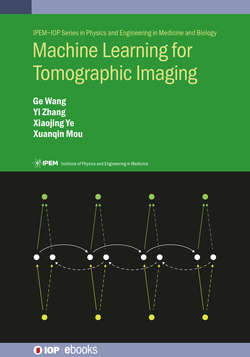Читать книгу Machine Learning for Tomographic Imaging - Professor Ge Wang - Страница 16
На сайте Литреса книга снята с продажи.
0.5 The organization of this book
ОглавлениеThis book reflects the state-of-the-art, since all of the co-authors are active researchers in the deep imaging field. Also, the materials are presented in a reader-friendly way, covering classic reconstruction ideas and human vision inspired insights, naturally leading to deep artificial neural networks and deep tomographic reconstruction. There are four parts in this book, with two to three chapters per part.
The first part consists of chapters 1–3, laying out the foundation for the remaining parts. The first chapter describes general principles for imaging, with an emphasis on the importance of prior information when data are imperfect, inconsistent, or incomplete, either in the Bayesian framework or in the context of the human vision system (HVS). From these perspectives, the concepts of regularization and sparsity naturally arise. The second chapter focuses on regularized image reconstruction in the Bayesian and compressed sensing perspectives, with an emphasis on dictionary learning, whose computational structure can be viewed as a single-layer neural network. As a good example, a statistical reconstruction algorithm is empowered with either a global or adaptive dictionary for low-dose computed tomography (CT). Based on the materials covered in chapters 1 and 2, chapter 3 offers a basic but quite complete presentation of neural network architectures, including the concepts and components of deep neural networks, representative networks such as auto-encoder, VGG, U-Net, ResNet, generative adversarial network (GAN), and graph convolutional network (GCN), as well as training, validation, and testing strategies.
The second part includes chapters 4 and 5, exclusively dedicated to CT. Chapter 4 reviews the CT data acquisition process and the development of CT scanners. Also, both analytic and iterative reconstruction algorithms are exemplified. In addition to analytic and iterative algorithms, chapter 5 covers the latest developments of the new type of reconstruction algorithm that employs deep neural networks. A number of recently published deep learning based methods are presented to show the feasibility, merits, and potential of deep learning techniques in the CT field.
The third part has chapters 6 and 7 on magnetic resonance imaging (MRI), in parallel to chapters 4 and 5. Chapter 6 reviews the MRI data acquisition process and the MRI scanner instrumentation. Fourier transform and compressed sensing algorithms are first presented. Then, classic post-processing algorithms are discussed. Chapter 7 covers various deep-learning-based MRI techniques, including a variety of deep reconstruction networks with applications to regular MRI, parallel MRI, dynamic MRI, and magnetic resonance fingerprinting (MRF). Miscellaneous topics are also covered, such as optimal k-space sampling and activation functions for complex-valued inputs. Finally, we discuss the integration of MRI data acquisition and image reconstruction with a synergized pulsing and imaging network (SPIN).
In the fourth part, we offer chapters 8–10. Chapter 8 briefly presents other imaging modalities including nuclear imaging, ultrasound imaging, and optical imaging in terms of working principles, and then describes representative neural networks developed for these imaging modalities individually. After that, we mention multi-modality imaging. Chapter 9 discusses image quality for general and task-specific assessment. In this chapter, network-based model observers are presented as a new approach for cost-effective reader studies. Chapter 10 is on quantum computing. We start with wave–particle duality and quantum puzzles, define quantum bits and gates, and touch upon quantum algorithms and quantum machine learning.
For your convenience, the relationships among the four parts and the associated chapters are summarized in figure 0.7, supplemented by appendices A and B. It is underlined that appendix B and associated web resources are under development, and should be invaluable to enhance the learning experience and AI/ML skills. As shown by this book, AI/ML techniques are applicable and instrumental to all tomographic modalities, and promise to unify individual modalities computationally.
Figure 0.7. Diagram suggesting the order in which the reader reads the components of this book.
